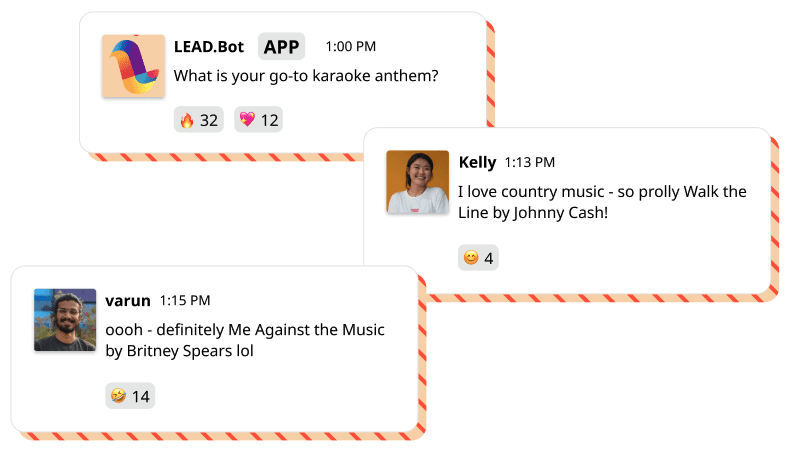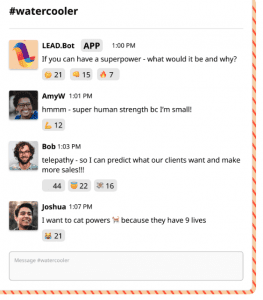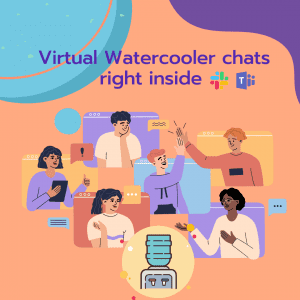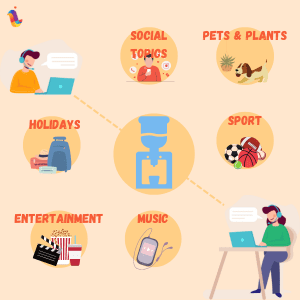The essence of water cooler chats resides in the casual, unplanned conversations that emerge around the office water cooler. These chats could range from discussing the latest plot twists in popular TV series or sports scores to shared reflections on workplace events or simple weather talk. Often, these spontaneous encounters provide a refreshing break from the demands and deadlines of work. Occasionally, water cooler meetups are intentionally planned to stimulate social interaction and the release of dopamine, the happiness hormone, through a good laugh or engaging discussion.
Watercooler in Traditional Office vs. Remote/Hybrid Work
In the traditional office setting, water cooler chats, owing to their informal and casual nature, provide ample opportunities for employees to socialize. It’s widely accepted that networking plays a crucial role in fostering teamwork, building relationships, and boosting productivity in the workplace. However, the pandemic-induced shift to remote work has put a halt to this beloved office tradition. Given the isolation that accompanies remote work, the need for team bonding and water cooler-like settings has never been greater. These casual interactions can significantly enhance employee engagement, mental health support, and morale. Hence, in light of the shift in work modes, organizations must acknowledge and incorporate the positive impact of casual conversations into the remote work day.
Enter the concept of the virtual water cooler, a digital equivalent to the physical office’s water cooler. This virtual space affords remote and hybrid teams the chance for casual interaction, fostering the same camaraderie found in physical office settings. Leveraging specific software can help facilitate these exchanges. This software can help structure interactions by providing conversation prompts or allowing team members to share information asynchronously. For instance, they could share personal experiences, photos, activities, or events, thereby encouraging camaraderie and mutual support. For HR professionals and people operations managers, these virtual water coolers are an invaluable tool, fostering connection and team cohesion in an increasingly remote work landscape.


Benefits Of Connecting Employees Through Informal Conversations With Water Cooler Topics
People want to work in organizations where they can communicate, be listened to, build trust and relationships, collaborate and grow. Water cooler chats provide opportunities to exchange ideas with others, brainstorm, and give and receive support and motivation to stay engaged. Some benefits of office water cooler talks with tangible effects on the organization include:
- Relationship building
Employee-employee: Remote work can quickly lead to work isolation and is one of the reasons for the formation of silos in the workplace. Without opportunities for relationship building and communication, employees may have negative experiences that can in turn affect the retention ability of the company. The connections formed at work have a positive impact on work life, emotions, and mental health. In a study of relationships at work by LinkedIn, 58% of men and 74% of women indicated that they would not trade camaraderie for a larger salary at a different company. While 46% of people believed that work friendships boost happiness. With work taking up a majority of time in the lives of many adults, having time to build trust and share experiences with other employees can create a sense of belonging and encourage the formation of friendships. A survey from Olivet Nazarene University showed that 35% of employees become friends at work, which can only occur from frequent social interactions with other members of staff.
Employee-management: Water cooler conversations open up casual channels of communication between employees and management that play a major role in improving relationships between management and employees, as well as breaking down barriers that could otherwise cause communication problems. With management being easily accessible, people operations also have access to information to help them put employees first and create transparency for healthy company culture.
2. Casual learning – for learning & development
Watercooler conversations can be a valuable source of casual learning in the workplace. These types of conversations often happen spontaneously and informally and can provide an opportunity for employees to exchange ideas, knowledge, and expertise on a variety of topics that may not necessarily be related to work.
For example, during a water cooler chat, employees may discuss recent news or current events, share tips on personal hobbies or interests, or discuss best practices for managing work-life balance. These conversations can help employees expand their horizons, learn new things, and develop new skills that may not be directly related to their job.
Moreover, water cooler conversations can help foster a sense of community and belonging in the workplace. By encouraging these types of conversations, employers can create a more inclusive and collaborative culture where employees feel valued for their diverse backgrounds, interests, and experiences
3. Encourage productivity
In a physical office, a walk to the water cooler can help manage fatigue, as well as mind and body strains from sitting in a particular position for long periods of time. These virtual water cooler conversations and activities are designed to encourage virtual teams to identify beneficial ways of working together that encourage new ideas and build on company culture. Virtual water cooler conversations offer small breaks from work that can be used to stretch the body and engage in meaningful conversation, which is all necessary to help manage focus, and energy levels, and gain a 10% to 15% bump in productivity throughout the workday.
4. Promote employee retention
Employee engagement is closely linked to talent retention because of the high cost of replacing key talent. Research by the Society for Human Resource Management showed that the cost of departure of an employee from an organization equals approximately one-third of the employee’s annual salary. The casual conversations around the water cooler are necessary because they help people catch up, break out of their shells, and foster an atmosphere that supports work-life balance, teamwork, employee engagement, and retention.
5. Build a company culture
Employees are the most important part of any organization and require a company culture and work environment that supports and empowers them. By encouraging breaks and incorporating team-building opportunities into the company culture, employees can enjoy breaks throughout their workday and cultivate relationships that help them enjoy their work and allows them to feel connected to the vision of the organization.
6. Establish employer brand
A company culture that promotes work-life balance, encourages employees to take breaks and be healthy, adds points to companies for being an attractive place to work, and goes a long way in employee experience and retention.
7. Supports creativity and innovation
Studies have been carried out to show that busy environments do not necessarily support creativity when compared to relaxed and casual chats which lead to greater successes and innovations. the founder and CEO of WallStreetZen, Nate Tsang, attributes the catalyst for starting his company to water cooler chats. Casual chats about thoughts and ideas help bring about fresh thinking that leads to new plans and directions.
Implementing Virtual Water Cooler Chats For Your Teams
Remote water coolers are easy to set up as part of the composition of a collaborative company culture. Irrespective of how your organization now works since the pandemic, on-site, remote, or hybrid; shared spaces for communication are an integral part of collaborations and the flow of information. In order to implement a virtual water cooler for your organization, you would need the following:
Choose the platform for interaction
Employee engagement apps like LEAD.bot are the easiest means of communication for virtual teams. Water cooler channels can be created in  LEAD.bot through Microsoft Teams and Slack, with customizable preferences and topics for the company and employees, to converse and hang out virtually.
LEAD.bot through Microsoft Teams and Slack, with customizable preferences and topics for the company and employees, to converse and hang out virtually.
👉Learn more about our AI-powered watercooler function
Invite team members
The water cooler groups can be company-wide or according to the department. People operations managers can coordinate the groups, and discover the hobbies and interests of the group to prepare the set of watercooler topics that are relatable and easy to spark conversations. Eventually, managers can plan for water cooler meetups outside the workspace that works towards keeping employees engaged and happy.
Schedule breaks or allows asynchronous contributions
Asynchronous discussions are more flexible, without any specific agenda, and allow people to add to the topic at their own convenience. However, assigning breaks also provides the benefit of having a team available at a scheduled time to interact without interruptions from work tasks.
Create topic areas and themes
Introducing icebreaker topics can be an interesting way to start a conversation and let people share information about themselves. These topics could be surrounding holidays or sharing of home office pictures, and within the team engagement apps like LEAD.bot, those water cooler topics are already curated with a wide range of categories for you to choose from.
Make water cooler chats a part of your virtual team-building activities
Encourage teammates’ participation by announcing the water cooler chat in your general channels, and build the whole subcategories behind that. For example, you can schedule live mastermind and brainstorming sessions. Or use a whiteboard tool like Miro with its virtual sticky notes so people can participate when they have time. These can be done via video call and can include activities such as book clubs for shared reading lists, birthday celebrations, virtual lunches, virtual happy hour, movies, games, and trivia nights.
Examples of Water Cooler Topics that Bring People Together

There are remarkable benefits to be gained in work environments that encourage water cooler chats, as they are useful ways to explore the interests of teammates and other employees in a casual way. As with many aspects of life, some topics of conversation should be avoided to prevent creating stress amongst people. The best topics do not require any expert knowledge, as they allow for the exchange and sharing of thoughts and ideas and can include common points such as:
• Holiday themes: Summer travels, Halloween, Christmas.
• Entertainment and art: Movies, TV shows, web series, plays.
• Music: Favourite artists, songwriters, concerts.Sports.
• Pets and plants.
• Others: Favorite social media apps, memes, and trending pictures.
LEAD by example with Watercooler chats
LEAD.bot serves as a connector for complex virtual teams and remote employees to have access to fast and smart connections within the work environment. By providing opportunities for mentoring and support through interesting prompts and activities that trigger interesting exchanges and communication with people across the organization. Using team engagement apps like LEAD.bot for water cooler chats and other casual breaks can strengthen inclusivity, collaboration, camaraderie, and conflict resolution between virtual teams whether cross-functional, by department, or by division.
LEAD’s Watercooler chats are set to introduce topic prompts to kick-start engaging conversations and casual debates in three easy steps:
1. Create a #watercooler channel
LEAD is available on Microsoft Teams and Slack. Watercooler chats can be set up on existing teams/channels or you can create a new water cooler team/channel for this purpose and team members are encouraged to participate.
2. Choose a topic or category
The Watercooler feature provided by LEAD.bot takes into consideration the need for varying levels of communication between employees and team members. The team can surf through numerous topics across various categories to choose prompts and conversation starters that bring about engagement and friendly debates.
3. Chat with colleagues
Take casual breaks to catch up with different team members across locations and time zones and engage in team-building activities.
👉Tutorial video on how to set up watercooler chat on Slack
👉Tutorial video on how to set up watercooler chat on Microsoft Teams
👉Tutorial on AI-powered watercooler function
Water coolers are an important part of physical offices and should therefore be made available for virtual teams, to engage on a personal level in ways that support motivation and productivity. Employers, managers, and people operations teams are encouraged to adopt relaxed policies around casual breaks, as this in turn makes management more approachable and accessible for the resolution of issues that leads to a positive work environment, improved employee experiences employee engagement, and retention.
It is important to pick a schedule and virtual space that remains casual and doesn’t become another task for employees to complete that can quickly become overwhelming and obstruct the goal of the water cooler activities. Therefore, the idea can be discussed with the virtual employees, so that a perfect balance can be attained for each person, without forcing participation. Also, structure and leadership are necessary, but should be approached from a hands-off point of view, to allow conversations and activities to progress organically.






